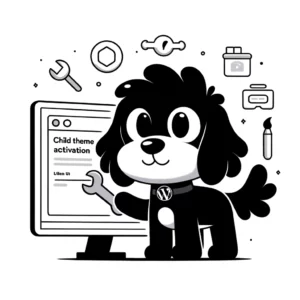Understanding Backlinks in WordPress
In WordPress, backlinks are vital for SEO as they signal the relevance and authority of a website’s content to search engines.
The Role of Backlinks in SEO
Backlinks, or inbound links, are hyperlinks from one website to another. They are a cornerstone of search engine optimization (SEO) because they demonstrate to search engines like Google the relevance and authority of a WordPress site’s content. When a website with a high domain authority links back to your site, it acts as a vote of confidence, boosting your site’s visibility on Google search results. This user endorsement helps improve the site’s perceived value, enhancing the overall user experience.
Types of Backlinks: Dofollow and Nofollow
Backlinks in WordPress are mainly categorized as dofollow and nofollow. A dofollow link is a typical hyperlink that allows search engines to follow and pass on PageRank or link equity, contributing to a site’s ranking. Conversely, a nofollow link includes a special HTML attribute that instructs search engines to ignore the link in terms of passing on authority. Website owners use nofollow links when linking to unverified content or in sponsored posts to align with Google’s algorithm standards and maintain SEO integrity.
How Backlinks Influence Search Engine Ranking
Backlinks are a critical ranking factor in Google’s algorithm. A WordPress website with backlinks from reputable and contextually relevant sources will likely rank higher. This is because Google interprets these backlinks as indicators of valuable content that enhances the searcher’s experience. However, it’s not just the quantity of backlinks that matters; the quality, relevance, and context of the linking domain are Paramount when it comes to how backlinks influence search engine ranking. A strategic approach to building backlinks can significantly elevate a site’s position in search engines.
Strategies for Acquiring High-Quality Backlinks
Acquiring high-quality backlinks is essential for boosting a website’s visibility and credibility. This section outlines effective strategies for building a robust backlink profile that enhances your site’s authority.
Content Creation: Blog Posts and Infographics
Creating compelling content is the cornerstone of attracting backlinks. Blog posts that offer valuable insights, provide actionable tips, or present original research in case studies are more likely to be linked to by authoritative websites. Similarly, infographics distill complex information into visual content that’s easily shareable, increasing the likelihood of gaining external links.
The Power of Guest Posting and Interviews
Guest posting on reputable sites is a dual-purpose strategy. It positions the author as an industry expert while securing high-quality backlinks from third-party sites. Securing interviews or becoming a source for influencers and bloggers similarly elevates credibility and fosters link building.
Leveraging Social Media and Forums for Links
Marketing content through social media channels can amplify its reach and facilitate backlinks. Engaging with communities on forums related to your niche invites opportunities for backlinks by establishing you as an informed and active participant in the subject matter. Sharing tutorials, long-form content, or videos provides additional value, prompting others to share and link to your site.
Each strategy mentioned here aims to organically grow your backlink portfolio, emphasizing quality over quantity, which is paramount for sustaining long-term SEO success.
Technical Aspects of WordPress Backlinking
In the landscape of WordPress SEO, understanding the technicalities of backlinking is essential for improving a site’s visibility and search engine ranking. Specific components such as anchor text, nofollow tags, and Google Search Console integration play pivotal roles in this process.
Anchor Text and Its Significance
Anchor text is the visible, clickable text in a hyperlink. In WordPress backlinking, it’s crucial because search engines use it to contextualize the linked page’s content. Optimal anchor text is concise, relevant to the page it’s connecting to, and includes keywords that reflect the page’s subject matter. For example, a link with the anchor text “WordPress Backlinks [2023] Best Practices and Tips” is more informative to both users and search engines compared to generic text like “click here.”
Implementing Nofollow Tags and When to Use Them
A nofollow tag is an HTML attribute used to instruct search engines that a hyperlink should not influence the ranking of the link’s target in the search engine’s index. It’s applied as rel="nofollow" within the hyperlink code. Here are instances when to use a nofollow tag:
- User-generated content: Such as comments or forum posts where links may not be trustworthy.
- Sponsored links: When the link is part of an advertisement or sponsorship arrangement.
- Non-relevant links: If the link does not provide value to the topic or content.
WordPress users can manually apply nofollow tags to hyperlinks or use plugins designed for link management.
Utilizing Google Search Console for Backlink Data
Google Search Console is a service provided by Google that helps users monitor, maintain, and troubleshoot their site’s presence in Google Search results. It offers valuable data on inbound links or backlinks, which are critical for SEO. By verifying their WordPress site with Google Search Console, users can:
- Review inbound link data: Identify which websites link back to their content.
- Evaluate link quality: Understand which backlinks are valuable based on relevancy and authority.
- Improve their link strategy: Focus on building backlinks that enhance their SEO and discard harmful ones.
A strategic approach to internal linking within WordPress also bolsters SEO. Creating coherent internal links with relevant anchor texts not only aids navigation but also reinforces keyword associations and distributes page authority throughout the site.
Promoting Your WordPress Site to Gain Backlinks
To effectively gain backlinks for a WordPress site, one must focus on outreach to build relationships with influencers, leverage various digital marketing techniques, and highlight social proof through reviews and testimonials. These strategies can significantly impact search engine ranking and website traffic.
Outreach and Building Relationships with Influencers
Reaching out and connecting with influential figures in a specific niche can lead to valuable backlinks and increased visibility. When shared appropriately, a blog post featuring original content or insights can attract the attention of an influencer. Personalizing communication and demonstrating how one’s content adds value encourages influencers to share it, potentially on popular sites with substantial followings.
Key Actions:
- Identifying influencers that resonate with the site’s brand.
- Crafting personalized messages that showcase the blog post’s unique angle.
Digital Marketing Techniques for Enhanced Visibility
Utilizing digital marketing strategies propels a WordPress site into the limelight, making it more likely to gather backlinks. Ethical SEO practices enhance Search engine ranking by avoiding black hat SEO techniques that harm credibility. Distributing a press release, maintaining active social media profiles, and engaging on platforms like Q&A sites effectively draw traffic and backlinks.
Techniques Include:
- SEO Optimization: Ensuring content is optimized for search engines.
- Social Media Engagement: Regularly updating social media platforms and interacting with followers.
The Importance of Social Proof Through Reviews and Testimonials
Social proof, such as reviews for others or testimonials on a site, solidifies trustworthiness and encourages others to link to the site. For instance, a well-maintained Gravatar can lend credibility to one’s digital persona, which is beneficial when commenting on blogs or leaving reviews. Showcasing a diverse portfolio on the site with client testimonials also entices peers to reference the work.
Strategies:
- Encouraging satisfied clients to leave positive reviews.
- Displaying a portfolio with clear, professional testimonials.
Best Practices for WordPress Backlinking
In search engine optimization (SEO), backlinks serve as a significant ranking signal, reflecting the credibility and relevancy of content. Successfully incorporating backlinks into a WordPress site hinges on adherence to SEO best practices and a clear, strategic approach.
Avoiding Black Hat SEO Tactics
High-quality content forms the bedrock of ethical link-building strategies. WordPress site owners should avoid black hat SEO tactics that can lead to penalization by search engines. Purchasing links or participating in link farms undermines the site’s integrity and long-term search engine optimization efforts. Instead, focus on crafting compelling content that naturally attracts backlinks.
Developing a Sustainable Long-Term Link Building Strategy
A sustainable link-building strategy integrates original research, keyword research, and building relationships with industry influencers. Tools like SEMrush or Ahrefs can aid in competitive backlink research and identify outreach opportunities. WordPress site managers should craft high-quality content that addresses the needs of their audience, which in turn encourages organic link acquisition.
Monitoring Your Backlinks and Analyzing Competitors
Regularly monitoring backlinks using SEO tools ensures that a WordPress site maintains a healthy backlink profile. This involves analyzing competitors to understand their backlink strategies and to spot potential link-building avenues. Through meticulous tracking and competitive backlink research, site owners can refine their strategy to improve their ranking and visibility.












